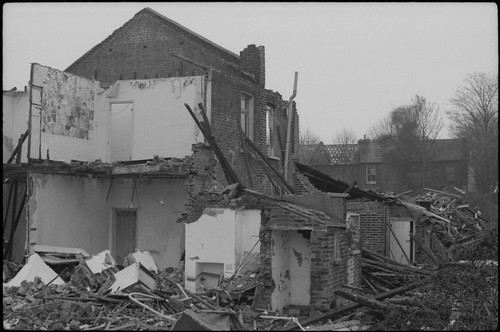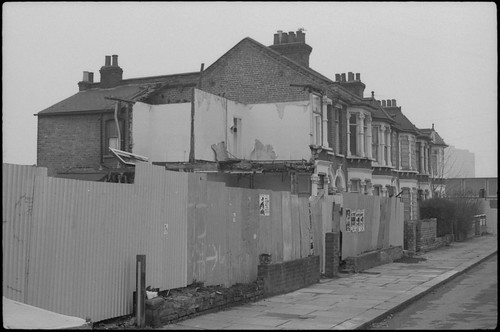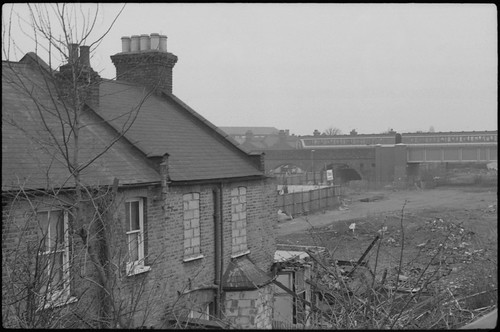 |
| Colville Road, 18th February 1994 |
At college, I found myself not knowing what kind of work to make. Conversations with the course tutors–one in particular–suggested that I should concentrate on painting and drawing from observation, this being seen as where my strengths lay. The course itself, however, was opening up possibilities, different ways to think about and to make artwork. Learning photography and using my first SLR camera began a turn away from making work by hand direct from the motif, although I was still doing some work like that. Having spent the previous summer filling a sketchbook with observational drawing, the camera had begun to supplant my sketchbook. Something which had had an impact at the time was seeing the American Art in the 20th Century exhibition at the Royal Academy in the autumn. I’d started making a number of Rauschenberg-inspired collages, which combined some of my photographs–including those from the M11 Link Road–with clippings from magazines, leaflets, and studio detritus. There was a lack of confidence in what I was doing though: I realised that everything that had been highly prized when studying A-level art was now no longer that important. Different values were in play. Concurrently, around this time I was beginning to attend some open days for degree courses, and, although the work I had been making was changing, I was still set then on studying painting (I subsequently failed to secure a place on a painting degree course, studying printmaking instead).

I returned with the same film in my camera on Friday the 18th February, and walked between Leytonstone and Leyton stations again, without returning to Wanstead; later that day I drew a schematic map of the route in my diary. The day before, I had a surprise in seeing a friend from school (who was still at school at the time) on the cover of the G2 section of the Guardian, in the middle of a crowd that had been on the Green the previous day, which must have been around the time of the evictions from the treehouse in the ancient chestnut tree there, its occupation an attempt to prevent the tree being cut down. Between Leytonstone and Leyton some of the houses had been demolished during the week since I’d failed to photograph them. Looking back, it’s interesting to note that many of my photographs of the route were taken on Dyers Hall Road, and on Colville Road, rather than on Claremont Road, the name of which became practically synonymous with the M11 Link Road protest. This may have been due to the fact the houses here were being actively demolished through the winter, while Claremont Road, as the focus of resistance to the road scheme, with the houses there occupied around the clock, was not substantially demolished until much later in the year–and all the houses on Claremont Road were marked for demolition, unlike Dyers Hall Road and Colville Road, both of which partially survived the road scheme. As a result, I seem to recall that Dyers Hall Road in particular had an eerie, deserted feeling. The misty weather on the 18th February when I took the photographs then only added to this.
The sequence of photographs begins on Dyers Hall Road, and unlike the previous occasions, this time I did take many more photographs of the same subjects in some cases, from different angles, moving closer and around the houses, aided by the fact that some of the corrugated iron fences had been torn down during the week on Colville Road, while I stood on some of the remaining garden walls on Dyers Hall Road, to achieve photographs like that below.
When I returned to photograph these locations in 2014, those photographs taken beyond the line of the fences from 1994 were impossible to recreate as these would be entirely within the cutting of the A12 road (the negatives from 2014 were somewhat dense and scanned less well that the thirty-year-old negatives from 1994).
In many cases, these were just photographs of the wall that runs alongside the A12. In the image immediately above, looking over the wall to the road was perhaps closer to the photograph from 1994 that precedes it; below, when trying to match the railway bridge in the background to the photograph taken in 1994, which really should be more wall and less sky, it provided a nearly abstract composition.
I again climbed the footbridge from Dyers Hall Road over the Central Line, to take a couple more photographs there, the second catching a North London Line train. One more house there had been demolished since the photographs made a month earlier.
There were just two photographs taken on Claremont Road that day, where the partially
demolished houses on the southern dog-leg of the road that I’d
photographed in January were now gone. I attempted to recreate the
viewpoint of these in two of the photographs taken in 2014, with the result
of one being almost entirely the blank wall of the new houses built
since (the viewpoint itself was almost certainly further back, hovering
over the A12: the advertising hoarding on the side of the house in the background at the left of the frame gives an indication of this).
When I retraced the route in 2014, I took a few additional photographs, not recreating those from 1994, but showing a little of the wider context, something I occasionally feel that I wished had done then, looking back down Colville Road from the footbridge at its end (which used to be a road bridge, although I don't really remember it as such), then, from the far side of the bridge, looking back towards Colville Road, where once the view would have shown the rear of the terraced houses backing onto the railway line, now long gone.
























No comments:
Post a Comment